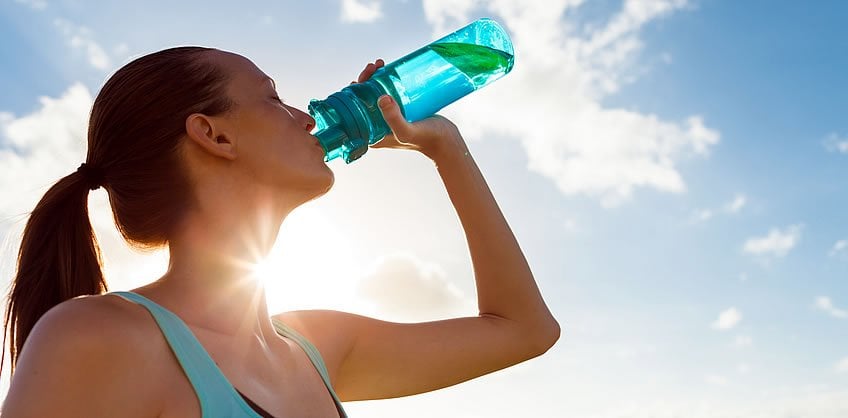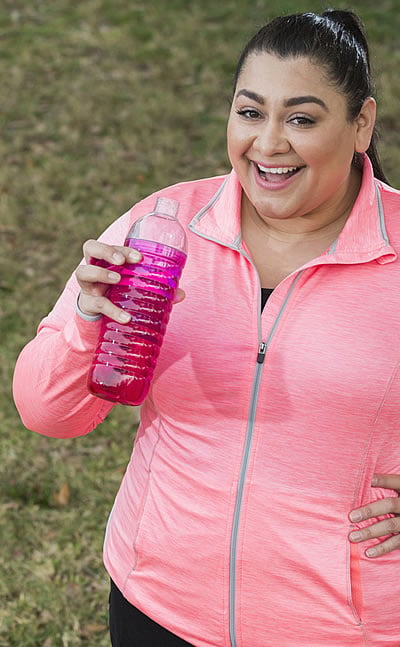6 Tips For Exercising Safely In Hot Weather
Here are top tips from our exercise physiologists for protecting your body in extreme heat.

Tip #1 For Exercising Safely In Hot Weather
Drink Up
Exercising in hot weather increases our body temperature. Sure, our bodies have built-in cooling systems that help us adjust to heat. That’s why we perspire. But this natural cooling system can fail if we’re exposed to soaring temperatures for too long. The result may be heat exhaustion – that awful fatigue that makes you feel as if one more step could be your last – and even heat stroke.
If the humidity is also way up, you’re in double trouble because your sweat “sticks” to your skin; it doesn’t evaporate as readily, which can send body temperature even higher.

To keep cool, make sure first of all that you’re drinking plenty of water. Since our bodies are about 50 to 60% water, it is vital to maintain this amount. We tend to lose about 2 to 3% during typical exercise and activity, especially on hot days. Because the Pritikin Eating Plan, full of fruits and vegetables, is so rich in water, you do not need to drink water before your workout, but while you’re exercising, drink 8 to 10 ounces of water every 20 minutes. After exercise, drink more – at minimum, another 8 ounces.
“Another great way to help re-hydrate during a break in physical activity is to eat a piece of fruit, such as an apple or orange, or even carrots or celery sticks,” recommends Ivan Ferran, Director of Clinical Exercise at the Pritikin Longevity Center + Spa. “The fruit or veggies will also help replace valuable electrolyte loss.”
Tip #2 For Exercising Safely In Hot Weather
Ease Up
If you’re used to working out in cooler climates, take it easy at first. Just accept the fact that you can’t do what you normally do. (This writer personally learned the hard way.) Though I normally breeze through a four-mile run at home on the beach in West Los Angeles, I barely made it through a half-mile stroll in the 103-degree heat of New York City’s Central Park last month. What a shock to realize how much – and how quickly! – the heat and humidity wore me down.
If you normally run, jog or walk. If you’re a brisk walker, slow it down. As your body adapts to the heat, gradually increase the pace and length of your workout. If you have a medical condition and/or take prescription medications, do ask your physician if you need to take any additional precautions.
Tip #3 For Exercising Safely In Hot Weather
Avoid the Hottest Part of the Day
Rise early to catch the cool of the morning, or go out at sunset or later. In the heat of midday, take cover under shade. Jump in a pool. Sign up for an aqua-aerobics class.
Tip #4 For Exercising Safely In Hot Weather
Wear Light-Colored, Lightweight Clothing
Dark colors absorb the heat, which can make you feel as if you’re wrapped in a warm blanket. Heavyweight, tight-fitting clothing will also heat you up. Keep it loose. Keep it light. More air will be able to circulate over your skin, keeping you cool.
Tip #5 For Exercising Safely In Hot Weather
Eat Snacks to Maintain Energy
But pick juicy snacks like fruit. The last thing you need in scorching heat are dry snacks like crackers, popcorn, or energy bars that require your body to add water. Plus, dry snacks are often dense with calories, which means they can easily foil weight-loss goals, summer or winter.
Tip #6 For Exercising Safely In Hot Weather
Know When to Say, “I’m Going Inside.”
Okay, okay, it kills you not to finish your four-mile workout. May we be so blunt as to suggest that it may kill you if you try. Paid heed to the heat. Listen to your body. If you’re feeling any of the following, find air-conditioned comfort fast.
- Weakness
- Light-headedness
- Dizziness
- Paling of the skin
- Headache
- Muscle cramps
- Nausea or vomiting
- Rapid heartbeat
“Remember that even a 20-minute workout has positive health effects. It’s the number of days you exercise that matters most. Frequency of days far outweighs the amount of time of any given exercise session,” says Scott.
Finally, “if it’s just too hot, stay indoors and do your resistance training!”